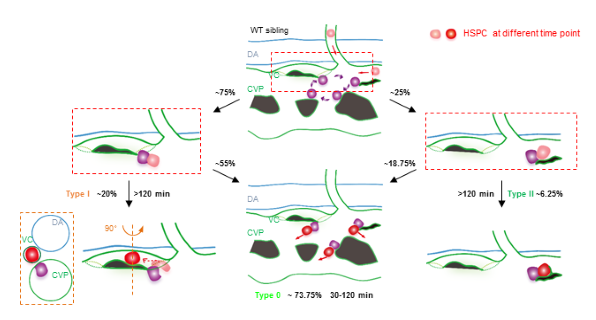
Fig. Schematic diagrams show how usher cells guide HSPCs into vascular niche. (Magenta cells are usher cells; VC indicates venous capillary and the green present vasculature)
With the support of National Natural Science Foundation of China (No. 31571505, 31371461), the research team of Professor Weijun Pan from Shanghai Institute of Nutrition and Health, Chinese Academy of Sciences, revealed the entire dynamic process of Hematopoietic Stem and Progenitor Cells (HSPCs) homing in vivo through high-resolution live imaging analysis. The results were recently published in Nature as a cover story on December 6th, 2018, entitled “VCAM-1+ macrophages guide the homing of HSPCs to a vascular niche” , The website link is: (http://www.nature.com/articles/s41586-018-0709-7)
Hematopoietic Stem and Progenitor Cells (HSPCs) give rise to all blood lineages, including red blood cells, white blood cells, platelets and others. The capabilities of HSPCs self-renewal, differentiation and construction of entire blood system rely on the process of HSPCs homing to hematopoietic tissue. ’Homing’ indicates the vital process that a specific group of cells in the circulation directionally migrate to certain microenvironment in tissues or organs to maintain cell fate or be functioning. Based on the homing capability of HSPCs, HSPCs transplantation is widely applied to treat human disease, including leukemia, immuno-disorder and cancers. However, due to limited methods to study this long-term and long-distance biological process, we still know little about how homing occurs in vivo, what is the microenvironmental structure for homing and how niche cells help HSPCs homing.
Using advanced live imaging and a cell-labelling system, the research team performed a high-resolution analysis of the HSPCs homing in zebrafish caudal hematopoietic tissue (CHT, equivalent to the fetal liver in mammals), they found retention hotspots were largely localized at the venous capillary confluence points which were connected to the CVP. Combined with accurate imaging and 3D remodeling, the researchers revealed the unique vascular structure of HSPCs homing microenvironment. Further study identified VCAM-1+ macrophage patrolling the inner surface of venous plexus, interacted with HSPCs via an ITGA4-dependent manner, and directed HSPCs retention. These cells, named “Usher cells”, guide HSCPs homing to two types of vascular niche.
This study provides new insights into the mechanism for HSPCs homing and reveals the essential role of a VCAM-1+ macrophage population with patrolling behavior in HSPCs retention.

Add: 83 Shuangqing Rd., Haidian District, Beijing, China
Postcode: 100085
Tel: 86-10-62327001
Fax: 86-10-62327004
E-mail: bic@clinicaltrials-nyph.org
京ICP备05002826号 文保网安备1101080035号 Copyright 2017 NSFC, All Right Reserved